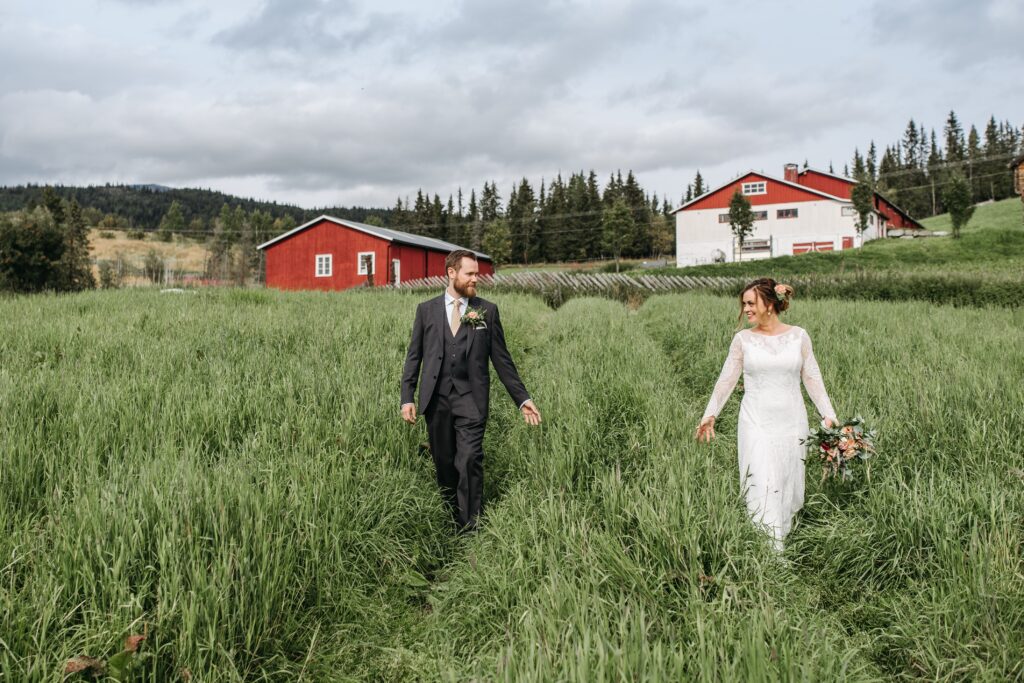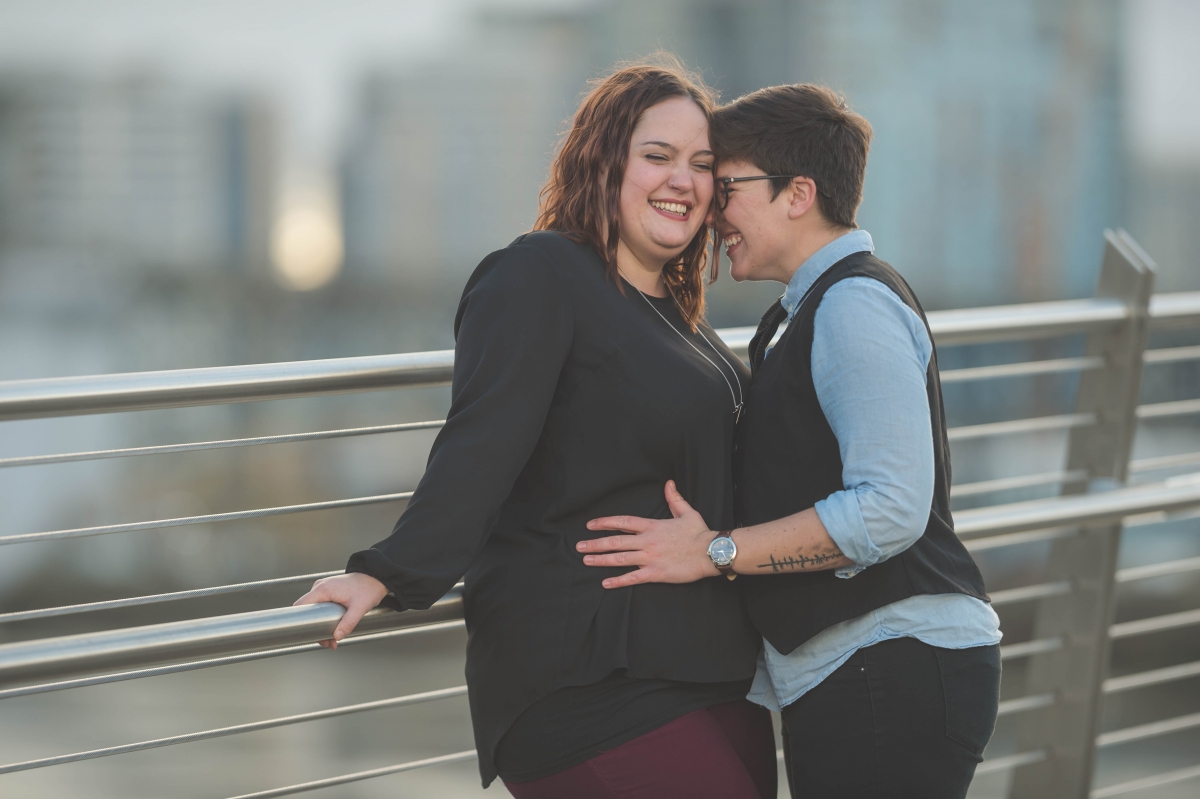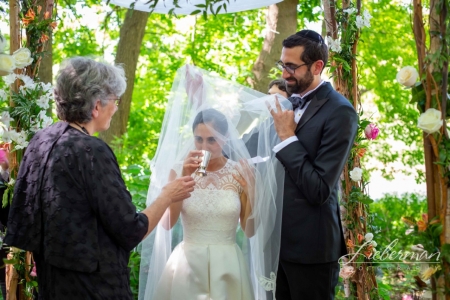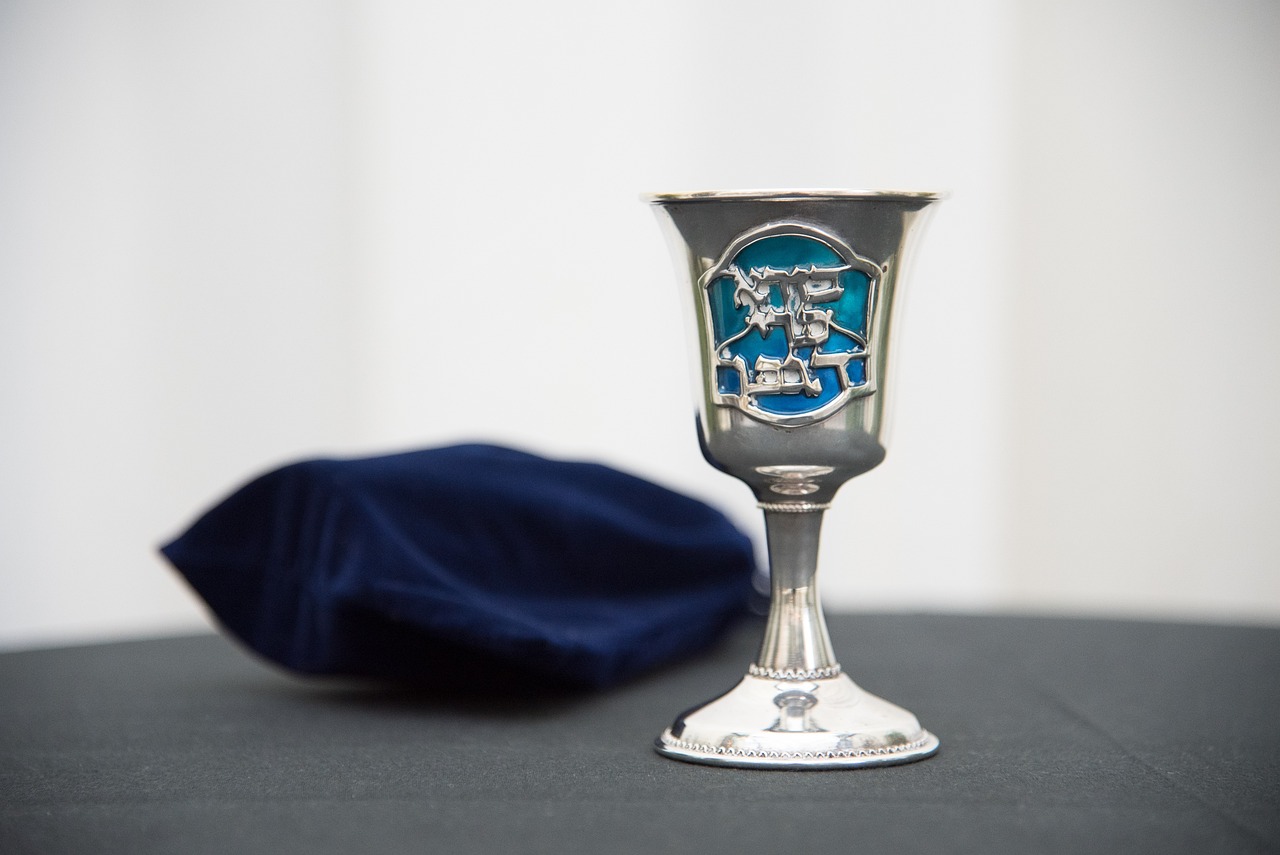Dear Family and Friends,
Welcome to our wedding! We’re so glad that you’re here celebrating with us. We put this booklet together to explain some of the symbols, traditions and rituals that you’ll see and, more importantly, participate in over the next few hours. If you read no further than this paragraph, though, please know that you are a critical part of this day’s success! In the Jewish tradition, it is a mitzvah (an imperative) to bring joy to the bride and groom who, according to tradition, are likened to a queen and king! We hope you’ll take up this role “seriously” and participate in the singing, dancing, shtick (antics), eating, and festivities over the course of the day. We’re excited you’re here!
Love, Phil and Julie
Schedule
11:30 Bride’s and Groom’s Tisches (Tables) / Kabbalat Panim (Receptions). Danish and coffee will be served in both locations.
12:00 Bedecken, including singing, talking, ketubah signing, dressing, and undressing (!)
12:30 Wedding ceremony
1:15 Cocktail reception followed by dancing and lunch
Preface
One of the things that we love about Judaism is the symbolism and possibilities for meaning-making. Just about every ritual you’ll see today has multiple interpretations. We’ve included the interpretations here that are in our thoughts today, the ones that have the most meaning for us. As is our usual custom, we have combined the traditional with the contemporary, tweaking each in order to create a day that is unique to us, yet rooted both in hundreds-year-old practices and in the emergent customs of our egalitarian, observant Jewish community.
The Booklet Cover
Hopefully the cover of this booklet looks familiar to you—the artwork is the same that we used for our invitation, and you will see it again on our benschers, books of blessings and songs, which will be distributed at lunch. The image will become even more familiar during the wedding ceremony, for the huppah (wedding canopy) under which we are married will also look like this. We love the two phrases quoted in the artwork: “the sound of joy, the sound of celebration, the voice of a bridegroom, the voice of a bride” is from one of the blessings that will help marry us today. (We’ll refer to it again later on.) We thought it particularly appropriate for us because we both love to sing, and because we hope to always have a household filled with our and our friends’ and families’ voices lifted up in music and song.
The second phrase, “Spread over us Your shelter of peace,” from the daily tefilah (liturgy), holds multiple meanings for us. First, it reflects our yearning for peace—for us, for our friends and families, for Israel and for the whole world. Second, it reflects our intention that the huppah itself will be a shelter of peace as we begin our married life together. A final interpretation is particularly meaningful to Julie, for she used this quote to drash (speak) both at David and Daryl’s wedding (her brother and sister-in-law) and at her Grandma Bluma’s shiva (mourning). Thus this quote links our wedding to these other important moments in her family’s recent history.
Thanks to Julie’s former roommate, ___________, a wonderful artist who made our artistic concept a beautiful reality.
Bride’s and Groom’s Tisches (Tables) / Kabbalat Panim (Reception)
This pre-ceremony space is an opportunity for guests to greet Phil and Julie and to begin to set the mood for the day. Each of us will sit at a tisch (Yiddish for “table”) in a separate room surrounded by family and friends offering up songs and words of blessing and learning. Julie’s tisch will be coordinated by her good friend and fellow Rosh Chodesher, ________. Both women and men are welcome at either or both tisches.
Words from our Hearts
Rabbi Meir Feldman, our mesader kiddushin (ceremony officiant), will invite everyone into the lobby. Julie and Phil will then be danced by their friends into the lobby for this next part of the pre-ceremony ritual. We will take a few moments to express words from our hearts, to share with each other and with all of you, our love for and our commitment to each other. This is the only opportunity during the day that we will have to speak our own words to each other with all of our friends and family as witnesses.
Ketubah Signing
The next order of “business” is signing the ketubah (marriage contract). Traditionally, the ketubah is written in Aramaic, the vernacular language of the Jews during the time of the Talmud, and reflects only the groom’s obligations to the bride. We have chosen to use a ketubah text written in Hebrew that reflects our mutual commitments to each other. The text, which is included in full a bit later on, speaks of our joint promises to support and sustain each other, not only materially, but also to take seriously what it means to create, nurture and build a loving partnership over a lifetime (b’sha’a tova/if all is as we hope). As a legal and binding document, the ketubah will be signed by two witnesses to confirm that we have taken on these commitments to each other. We have asked Julie’s good friend and fellow Rosh Chodesher, __________, and Phil’s friend from his year of study in Israel and from Yeshiva University, _________, to be the ketubah witnesses. The ketubah itself is a design by an Israeli artist and depicts Shivat ha-Minim, or the Seven Species, mentioned in the Torah (Bible).
Bedecken
This part of the day continues with the bedecken. Bedecken literally means “to cover.” A common explanation for this ritual is that it hearkens back to the Biblical narrative in Genesis 29 where Jacob was to marry Laban’s younger daughter, Rachel, but Laban deceived Jacob into marrying Leah, Laban’s older daughter. According to the Jewish tradition, Laban was able to deceive Jacob into marrying Leah by veiling her and presenting her as the bride rather than Rachel. Thus, the groom checks the bride before veiling (“covering”) her, making sure that she is the one he does, in fact, want to marry. (Seeing as Julie doesn’t have any sisters, Phil’s not too worried, but you never know!) After Phil checks and “covers” Julie, her mom will unveil her so she can come to the huppah (wedding ceremony) feeling fully present, able to see and to be seen.
Here, too, we meld the old with the new. Phil has chosen to join Julie in wearing white at the huppah, symbolizing purity and the seriousness of the day. Phil will wear a kittel, the traditional simple white robe worn (historically by a man, today by some women and men) on the wedding day, on Yom Kippur, at the Passover seder, and at burial—all times of great kedushah (sanctity) and profound transition. To continue the bedecken and to mirror Phil’s “covering” of Julie with the veil, Julie will “cover” Phil by dressing him in his kittel. Through these intimate acts, Phil and Julie symbolically express their commitment to care for and protect each other. Phil is also wearing a kippah (yarmulke) that Julie had made especially for our wedding weekend.
As the bedecken ends, Rabbi Feldman will invite everyone to proceed to the room for the wedding ceremony.
Wedding Ceremony
The Huppah
The wedding ceremony takes place underneath a huppah (canopy). The huppah symbolizes, among other things, the home that we are creating as we begin our married life together—a home, like the huppah, which is open to and supported by friends, family, and community. The huppah‘s open sides and temporary structure are also reminiscent of our spiritual ancestors Abraham and Sarah’s tent (described in Genesis 18) and the hospitality that they offered to arriving travelers and angels (which Julie spoke about at her bat mitzvah. We’re sure that those of you who were there remember it well!).
For our huppah, we are using the new tallit (prayer shawl) that Phil gave to Julie as a wedding present. The atarah (literally “crown,” or top, decorative part) is from Yad L’Kashish (Lifeline for the Elderly) in Jerusalem, and depicts the Shivat ha-Minim, like our ketubah.
The Processional
We ask that our guests stand as Phil and Julie enter the room and walk down the aisle. One explanation for this custom is that the bride and groom on their wedding day are likened to a queen and king.
We are thrilled that our families are honoring us by walking down the aisle along with us today. Members of Phil’s family will precede him, walking to the melody of “Eli, Eli.” Phil will walk down the aisle accompanied by his parents, ___________, and the melody from the poem Yedid Nefesh. Julie’s brother, and sister-in-law, will precede her, walking to the tune of Erev Shel Shoshanim. Julie will walk down the aisle accompanied by her parents, and the melody from Bo’i v’Shalom.
The Ceremony
While our parents join Rabbi Feldman under the chuppah to show the important place that family holds in our lives, Phil and Julie begin their wedding ceremony together outside of the huppah to symbolize their joining together of two independent lives. We will each circle the other three-and-a-half times, for a total of seven circles. Seven is a very meaningful number in the wedding and in Jewish tradition in general—the seven blessings you’ll hear later help to effectuate the marriage; there are seven days in the creation of the world—seven is considered to be a sign of wholeness and completion. The circling has its own set of meanings. It is associated with the creation of a world which belongs to us alone, and the symbolic invocation of divine protection for each other at this important step in our lives. Rabbi Feldman has suggested another interpretation that we really like—we circle each other to represent that while we individually will travel worlds throughout our marriage, our partner will always be our anchor and our home.
After we circle each other, we will proceed into the huppah, where Rabbi Feldman will welcome us by singing “Barukh ha-Ba,” in Hebrew—”Welcome! May the One who is mighty, blessed, great and supreme beyond all, bless the groom and bride.”
Kiddushin, including Erusin
The blessings of Erusin represent the couple’s formal betrothal. In ancient times, Erusin preceded the marriage itself by as much as a year. Today, Erusin takes place just before Nisuin, the marriage proper. Erusin consists of two blessings. The first is over a cup of wine, the first of two used during the wedding ceremony. For this cup, we are using the kiddush (wine sanctification) cup that Julie has used in creating her Jewish home and hosting Shabbat meals, a gift from her friend, __________. The second Erusin blessing refers to permitted and forbidden sexual partners and ends with “Blessed are You, Eternal, who sanctifies Israel through the wedding canopy and kiddushin.”
Kiddushin is the rings part of the ceremony and is what effectuates the formal betrothal. The rings we will be offering to each other are metal bands without any stones or perforations, in order to symbolize completeness and wholeness. Julie’s cousins, _____________, are honoring us by keeping the rings safe and bringing them forward at the appropriate time.
Like the ketubah, the offering of the rings must be performed in the presence of two designated edim (witnesses). We are honored that _________ and __________ are serving as these edim. Phil will offer a ring to Julie with the following words: “With your permission and your consent, behold with this ring you shall be my wife, according to the laws of Moses and Israel.” From among the many alternative formulations the rabbinic tradition permits to be used, we chose this one—which is mentioned in the Talmud and the Jewish legal codes of Maimonidies and Rabbi Joseph Karo—rather than the more common “with this ring you are consecrated to me.” Julie will demonstrate her acceptance of the ring by moving it from her index finger to her ring finger. According to traditional halakhah (Jewish law), the groom’s giving of a ring to the bride effectuates kiddushin.
Julie will then offer a ring to Phil with the words of Hosea (2:21–22): “I will betroth you to me forever, I will betroth you with righteousness and justice, and with goodness and mercy, and I will betroth you with faithfulness.” Phil will demonstrate his acceptance of the ring by moving it from his index finger to his ring finger. We exchange these rings to reflect our mutual commitment to a marriage of equals and, as it says in our ketubah, “for the purposes of creating this marriage and to symbolize our love.”
Ketubah
While we signed the ketubah earlier, we take a few moments here to read this important legal document so that you all will know to what we have agreed. In this way, our family and friends are witnesses to all of the parts the wedding ceremony. _____________ and ___________will read the ketubah in Hebrew and English, respectively.
Ketubah text
On the __ day of Parshat Shemot, on the ___ day of the Jewish month of ___, ___, corresponding to __________, in _________, _________, we hereby testify that the groom, Philip ____, son of ____ and _______, said to his bride, Julie___________, daughter of ________ and _______, “With your permission and your consent, with this ring you shall be my wife, according to the laws of Moses and Israel,” and that the bride, Julie, said to the groom, Phil, “I will betroth you to me forever, I will betroth you with righteousness and justice, and with goodness and mercy, and I will betroth you with faithfulness.”
And our bride and groom accepted all the conditions of betrothal and marriage as set forth by biblical law and by the rulings of the Sages of blessed memory. Furthermore, the groom Phil and his bride Julie agreed willingly to work for one another, to honor, support and nurture one another, to live with one another and to build together a household of integrity as befits Jewish people. The bride accepted a ring from the groom, and the groom accepted a ring from the bride, for the purposes of creating this marriage and to symbolize their love.
The two of them come and say in a faithful promise, let us join as partners in the will of our souls. We agree to build and maintain our partnership, our family, and our community together in faith and in peace. We take upon ourselves by solemn promise to live a life of full partnership of the home, of the spirit, and of the mind. We agree to uphold a faithful home in Israel, which we will keep at the forefront of our priorities. We agree to create a separate time and space each year, in the season of our betrothal, to stand amidst the love and mistakes of the year that has passed and make a reckoning of it, and look to the time to come.
The groom Phil and the bride Julie also accepted full legal responsibility for the obligations herein taken on, as well as for the various property entering the marriage from their respective homes and families, and agreed that the obligations in this contract may be satisfied even from movable property. We have had both the groom and the bride formally acquire these obligations to the other, with an instrument fit for such purposes. Thus all is in order and in force.
Nisuin
Nisuin is the marriage ceremony itself. This ritual consists of the sheva brachot (seven blessings) under the huppah. These sheva brakhot link the couple’s marriage to themes of creation of humanity and the redemption of the Jewish people. Here, Rabbi Feldman will sing the sheva brakhot over the second cup of wine. For this cup, we use a new kiddush (wine) cup that we bought together for this specific purpose, symbolizing our life together and new beginnings. After the final blessing, Julie and Phil will drink from the same cup of wine. The seven blessings are:
- Blessed are You, Eternal our God, Sovereign of the universe, Creator of the fruit of the vine.
- Blessed are You, Eternal our God, Sovereign of the universe, who created everything for Your glory.
- Blessed are You, Eternal our God, Sovereign of the universe, who formed the first human.
- Blessed are You, Eternal our God, Sovereign of the universe, who created humanity in Your image, patterned after Your image and likeness, and enabled them to perpetuate this image. Blessed are You, Eternal, who created humanity.
- Bring joy and exultation to the barren one [Israel] as her children are joyfully gathered to her. Blessed are You, Eternal, who makes Zion glad with her children.
- Grant great joy to these loving companions, as You once gladdened your creations in the Garden of Eden. Blessed are you, Eternal, who gladdens the groom and bride.
- Blessed are You, Eternal our God, Sovereign of the universe, who created joy and gladness, groom and bride, mirth, glad song, pleasure and delight, love and harmony, peace and companionship. May it be your will Eternal our God that there will soon be heard in the cities of Judah and streets of Jerusalem the voice of joy, the voice of gladness, the voice of groom, and the voice of bride, the sound of grooms rejoicing under the wedding canopy and of youths feasting and singing. Blessed are You, Eternal, who gladdens the groom with the bride.
You’ll notice that it is from this seventh blessing that the quote on the front of this booklet comes.
Ending the Ceremony
Rabbi Feldman will then offer the ancient words of the priestly blessing to send us on our way. To hear the blessing, Phil and Julie will wrap themselves in the new tallit (prayer shawl) that Julie gave to Phil as a wedding gift.
The ceremony then concludes with Julie and Phil breaking a glass. While this ritual is often seen as the cue to shout “mazal tov” (“congratulations”), it has real significance within the wedding ceremony. The most meaningful interpretation for us is that we break the glass in order to recognize that even as we are filled with immeasurable joy, we do not forget that the world is broken in many ways and that we are responsible for helping in its repair. Toward that end, we are noting the occasion of our wedding, and thanking our guests for attending, by donating to several charities that are meaningful to us. We have listed them at the end of this booklet. We also want to make special mention here of brokenness that we see in the world specifically related to marriage and weddings—the many agunot, Jewish women unable to remarry because their husbands refuse to grant them a get (divorce under Jewish law), and gays and lesbians whose marriages are not recognized by some Jewish legal authorities or by U.S. civil law. While we are thrilled to be getting married today, we understand that this is a privilege not available to everyone, and we commit to giving tzedakah (donations to charity) to help repair the world in these ways.
After the Ceremony
As soon as we break the glass, we invite you to dance with us as we head for the yichud room. Yichud means “being alone together,” and is the only time during the wedding that we will have a few minutes for ourselves. It is also where we’ll have a bite to eat. _________, and ______________ will serve as the shomrim (guards). Their job is to ensure that we are not disturbed during the yichud period.
Please enjoy the cocktail reception, to be followed by the wedding luncheon and dancing! The meal and party have special status in Jewish tradition as a seudat mitzvah, a feast that is a sacred obligation; you are not just guests at this party, but active participants charged with one important and holy task: to celebrate with the bride and groom! Shtick or “antics” will likely be a major feature of the afternoon—please join in!
We ask, in deference to Phil’s family’s custom, that for the first set of dancing, women form one circle and men form a separate circle. All other dancing will be mixed.
At the end of the meal, we conclude with Birkat ha-Mazon (Grace after Meals), which will include a repetition of the sheva brakhot (seven blessings) read by several of our dear friends. For this, we need a third kiddush cup, and we are using one that Julie’s Rosh Chodesh group gave her, full of blessings, as a wedding gift.
And, thus, the wedding ends! We’re so glad that you were here!!
We are missing…… May their memories be for a blessing.
Thank you to…
Tzedakah (Giving)
The organizations that we are donating to in honor of our wedding are:
Atzum empowers social justice projects to assist those severely disadvantaged by inadequate access to Israeli public protection or private concern, including help to victims of terrorism in Israel and aid to foreign workers. www.atzum.org
Agunah International Inc. helps free women trapped in dead marriages by husbands who refuse to grant them a Jewish divorce (get), counsels women whose unscrupulous husbands use the get as a weapon to extort financial gain or custodial rights, or to exact revenge during the divorce proc ess, and provides funds for agunot in need. www.agunahinternational.com
The Legal Aid Society of NYC provides a wide variety of legal services for people who cannot afford a lawyer. www.legal-aid.org
Ma’yan envisions a Jewish community fully inclusive of women and serves as a catalyst for change and resource for women working for change within the Jewish community. www.mayan.org
Mazon provides food, help and hope to hungry people of all faiths and backgrounds. www.mazon.org
The Nature Conservancy works to preserve the plants, animals and natural communities that represent the diversity of life on Earth by protecting the lands and waters they need to survive. www.nature.org
The Riverside Choral Society performs classical choral music in New York City. Julie has been a member since 1994. www.riversidechoral.org
The Shefa Fund’s Pooled Fund for Jewish Community Activism on Gay/Lesbian/Bisexual Issues. www.shefafund.org
Used by permission of Phil Richter and Julie Sissman












